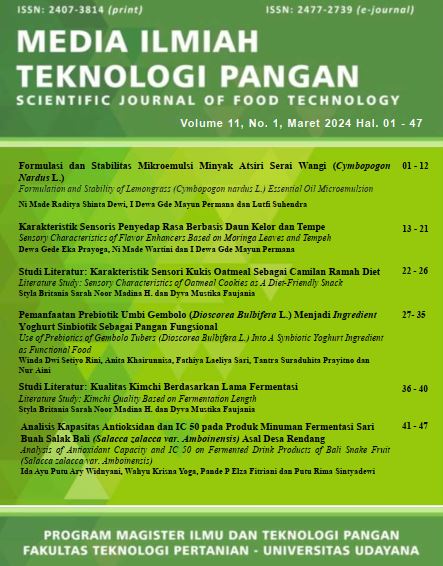Formulasi dan Stabilitas Mikroemulsi Minyak Atsiri Serai Wangi (Cymbopogon nardus L.)
Abstrak
Lemongrass essential oil microemulsions can be used as natural preservatives by enhancing their solubility stability and effectiveness. This study aims to determine the effect of the surfactant combination ratio (Tween 80, Span 80, and Tween 20) and lemongrass essential oil on the characteristics of lemongrass essential oil microemulsion, as well as to determine the optimal surfactant combination ratio (Tween 80, Span 80, and Tween 20) and lemongrass oil ratio that yields the most stable microemulsion characteristics for lemongrass oil. The study was conducted in two stages using a Completely Randomized Design, followed by an Honest Significant Differences follow-up test. The first stage involved two factors. The first factor was the ratio of the surfactant mixture (Tween 80: Span 80: Tween 20), denoted as S1 (2,5:97:0,5), S2 (2,5:96,8:0,7), S3 (2,5:96,5:1), S4 (2,5:96,3:1,2), and S5 (2,5:96:1,5). The second factor was the ratio of surfactant to citronella oil, represented by F1 (90:10), F2 (85:15), F3 (80:20), F4 (75:25), and F5 (70:30). The results indicated that the turbidity index value was influenced by the ratio of the surfactant mixture and lemongrass essential oil, along with their interactions, both before and after centrifugation, and heating. The conclusion drawn from this study is that the F2S3 treatment represents the optimal formula for producing lemongrass essential oil microemulsions. This formula exhibits characteristic turbidity index values before centrifugation (0,153%), after centrifugation (0,173%), and after heating (0,229%) with a droplet size of 29,2 nm and a zeta potential value of 0,1 mV. Additionally, the microemulsion remains stable during an 8-week storage period.





